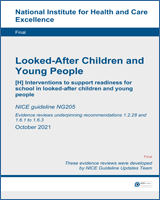| Association between being in the intervention group and foster parent and girl reported internalising problems at 6 months (Parent Daily Report Checklist) | 100 | β −0.28 P<0.01 | Very Low | Intervention was associated with a more favourable outcome |
| Association between being in the intervention group and foster parent and girl reported externalising problems at 6 months (Parent Daily Report Checklist) | 100 | β −0.21 P<0.01 | Very Low | Intervention was associated with a more favourable outcome |
| Association between being in the intervention group and foster parent and girl reported prosocial behaviour at 6 months (Parent Daily Report Checklist) | 100 | β 0.15 P>0.05 | Very Low | No association was observed between intervention and outcome |
| Prosocial behaviour score at 12 months follow up (subscale from Parent Daily Report Checklist) | 100 | MD 0.06 (0.01 to 0.11) | Very Low | Effect favours intervention group, but it may be less than the MID |
| Association with delinquent peers score at 12 months follow up (modified version of the general delinquency scale from the Self-Report Delinquency Scale) | 100 | Beta −0.21, SE 0.09, P<0.05 | Very Low | Effect favours intervention group, but it may be less than the MID |
| Caregiver-reported Internalising/externalising symptoms score at 2 years follow up (Achenbach System of Empirically Based Assessment) | 100 | MD 0.27 (−3.03 to 3.57) | Very Low | No meaningful difference |
| Delinquent behaviour score at 3 years follow up (Self-Report Delinquency Scale) | 100 | MD −0.65 (−1.43 to 0.13) | Very Low | Could not differentiate |
| Association with delinquent peers score at 3 years follow up (modified version of the general delinquency scale from the Self-Report Delinquency Scale) | 100 | MD −0.34 (−0.71 to 0.03) | Very Low | Could not differentiate |
| Composite substance use score at 3 years follow up (girls were asked how many times in the past year they had (a) smoked cigarettes or chewed tobacco, (b) drank alcohol (beer, wine, or hard liquor), and (c) used marijuana). | 100 | MD −0.74 (−1.33 to −0.15) | Very Low | Effect favours intervention group, but it may be less than the MID |
| Tobacco use score at 3 years follow up (see above) | 100 | MD −0.87 (−1.69 to −0.05) | Very Low | Effect favours intervention group, but it may be less than the MID |
| Alcohol use score at 3 years follow up (see above) | 100 | MD −0.31 (−0.78 to 0.16) | Very Low | Could not differentiate |
| Marijuana use score at 3 years follow up (see above) | 100 | MD −1.04 (−1.74 to −0.34) | Very Low | Effect favours intervention group, but it may be less than the MID |
